公司的核心竞争力-外文翻译
- 格式:doc
- 大小:41.50 KB
- 文档页数:8
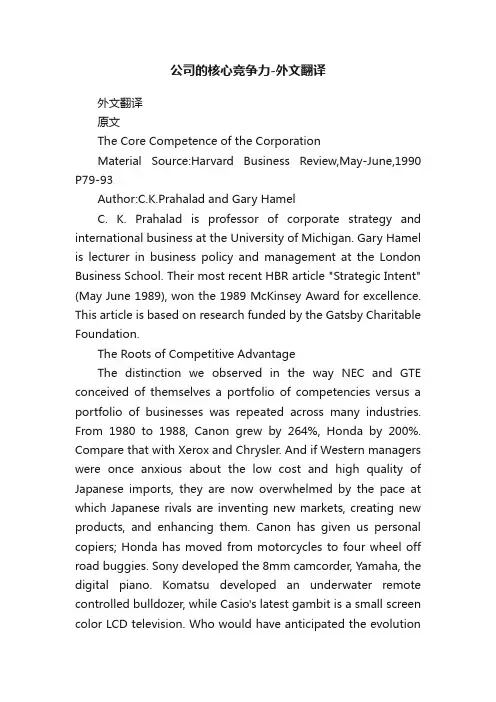
公司的核心竞争力-外文翻译外文翻译原文The Core Competence of the CorporationMaterial Source:Harvard Business Review,May-June,1990 P79-93Author:C.K.Prahalad and Gary HamelC. K. Prahalad is professor of corporate strategy and international business at the University of Michigan. Gary Hamel is lecturer in business policy and management at the London Business School. Their most recent HBR article "Strategic Intent" (May June 1989), won the 1989 McKinsey Award for excellence. This article is based on research funded by the Gatsby Charitable Foundation.The Roots of Competitive AdvantageThe distinction we observed in the way NEC and GTE conceived of themselves a portfolio of competencies versus a portfolio of businesses was repeated across many industries. From 1980 to 1988, Canon grew by 264%, Honda by 200%. Compare that with Xerox and Chrysler. And if Western managers were once anxious about the low cost and high quality of Japanese imports, they are now overwhelmed by the pace at which Japanese rivals are inventing new markets, creating new products, and enhancing them. Canon has given us personal copiers; Honda has moved from motorcycles to four wheel off road buggies. Sony developed the 8mm camcorder, Yamaha, the digital piano. Komatsu developed an underwater remote controlled bulldozer, while Casio's latest gambit is a small screen color LCD television. Who would have anticipated the evolutionof these vanguard markets?In more established markets, the Japanese challenge has been just as disquieting. Japanese companies are generating a blizzard of features and functional enhancements that bring technological sophistication to everyday products. Japanese car producers have been pioneering four wheel steering, four valve-per cylinder engines, in car navigation systems, and sophisticated electronic engine management systems. On the strength of its product features, Canon is now a player in facsimile transmission machines, desktop laser printers, even semiconductor manufacturing equipment.In the short run, a company's competitiveness derives from the price/performance attributes of current products. But the survivors of the first wave of global competition, Western and Japanese alike, are all converging on similar and formidable standards for product cost and quality minimum hurdles for continued competition, but less and less important as sources of differential advantage. In the long run, competitiveness derives from an ability to build, at lower cost and more speedily than competitors, the core competencies that spawn unanticipated products. The real sources of advantage are to be found in management's ability to consolidate corporatewide technologies and production skills into competencies that empower individual businesses to adapt quickly to changing opportunities.Senior executives who claim that they cannot build core competencies either because they feel the autonomy of business units is sacrosanct or because their feet are held to the quarterly budget fire should think again. The problem in many Western companies is not that their senior executives are any less capable than those in Japan nor that Japanese companies possess greatertechnical capabilities. Instead, it is their adherence to a concept of the corporation that unnecessarily limits the ability of individual businesses to fully exploit the deep reservoir of technological capability that many American and European companies possess.The diversified corporation is a large tree. The trunk and major limbs are core products, the smaller branches are business units; the leaves, flowers, and fruit are end products. The root system that provides nourishment, sustenance, and stability is the core competence. You can miss the strength of competitors by looking only at their end products, in the same way you miss the strength of a tree if you look only at its leaves. (See the chart "Competencies: The Roots of Competitiveness.”) Core competencies are the collective learning in the organization, especially how to coordinate diverse production skills and integrate multiple streams of technologies. Consider Sony's capacity to miniaturize or Philips's optical media expertise. The theoretical knowledge to put a radio on a chip does not in itself assure a company the skill to produce a miniature radio no bigger than a business card. To bring off this feat, Casio must harmonize know how in miniaturization, microprocessor design, material science, and ultrathin precision casing the same skills it applies in its miniature card calculators, pocket TVs, and digital watches.If core competence is about harmonizing streams of technology, it is also about the organization of work and the delivery of value. Among Sony's competencies is miniaturization. To bring miniaturization to its products, Sony must ensure that technologists, engineers, and marketers have a shared understanding of customer needs and of technological possibilities. The force of core competence is felt as decisively inservices as in manufacturing. Citicorp was ahead of others investing in an operating system that allowed it to participate in world markets 24 hours a day. Its competence in provided the company the means to differentiate itself from many financial service institutions.Core competence is communication, involvement, and a deep commitment to working across organizational boundaries. It involves many levels of people and all functions. World class research in, for example, lasers or ceramics can take place in corporate laboratories without having an impact on any of the businesses of the company. The skills that together constitute core competence must coalesce around individuals whose efforts are not so narrowly focused that they cannot recognize the opportunities for blending their functional expertise with those of others in new and interesting ways.Core competence does not diminish with use. Unlike physical assets, which do deteriorate over time, competencies are enhanced as they are applied and shared. But competencies still need to be nurtured and protected; knowledge fades if it is not used. Competencies are the glue that binds existing businesses. They are also the engine for new business development. Patterns of diversification and market entry may be guided by them, not just by the attractiveness of markets.Consider 3M's competence with sticky tape. in dreaming up businesses as diverse as "Post it" notes, magnetic tape, photographic film, pressure sensitive tapes, and coated abrasives, the company has brought to bear widely shared competencies in substrates, coatings, and adhesives and devised various ways to combine them. Indeed, 3M has invested consistently in them. What seems to be an extremely diversified portfolio ofbusinesses belies a few shared core competencies.In contrast, there are major companies that have had the potential to build core competencies but failed to do so because top management was unable to conceive of the company as anything other than a collection of discrete businesses. GE sold much of its consumer electronics business to Thomson of France, arguing that it was becoming increasingly difficult to maintain its competitiveness in this sector. That was undoubtedly so, but it is ironic that it sold several key businesses to competitors who were already competence leaders Black & Decker in small electrical motors, and Thomson, which was eager to build its competence in microelectronics and had learned from the Japanese that a position in consumer electronics was vital to thischallenge.Management trapped in the strategic business unit (SBU) mind set almost inevitably finds its individual businesses dependent on external sources for critical components, such as motors or compressors. But these are not just components. They are core products that contribute to the competitiveness of a wide range of end products. They are the physical embodiments of core competencies.How Not to Think of CompetenceSince companies are in a race to build the competencies that determine global leadership, successful companies have stopped imagining themselves as bundles of businesses making products. Canon, Honda, Casio, or NEC may seem to preside over portfolios of businesses unrelated in terms of customers, distribution channels, and merchandising strategy. Indeed, they have portfolios that may seem idiosyncratic at times: NEC is the only global company to be among leaders in computing,telecommunications, and semiconductors and to have a thriving consumer electronics business.But looks are deceiving. In NEC, digital technology, especially VLSI and systems integration skills, is fundamental. In the core competencies underlying them, disparate businesses become coherent. It is Honda's core competence in engines and power trains that gives it a distinctive advantage in car, motorcycle, lawn mower, and generator businesses. Canon's core competencies in optics, imaging, and microprocessor controls have enabled it to enter, even dominate, markets as seemingly diverse as copiers, laser printers, cameras, and image scanners. Philips worked for more than 15 years to perfect its optical media (laser disc) competence, as did JVC in building a leading position in video recording. Other examples of core competencies might include mechantronics (the ability to marry mechanical and electronic engineering), video displays, bioengineering, and microelectronics. In the early stages of its competence building, Philips could not have imagined all the products that would be spawned by its optical media competence, nor could JVC have anticipated miniature camcorders when it first began exploring videotape technologies.Unlike the battle for global brand dominance, which is visible in the world's broadcast and print media and is aimed at building global "share of mind,” the battle to build world class competencies is invisible to people who aren't deliberately looking for it. Top management often tracks the cost and quality of competitors' products, yet how many managers untangle the web of alliances their Japanesecompetitors have constructed to acquire competencies at low cost? In how many Western boardrooms is there an explicit,shared understanding of the competencies the company must build for world leadership? Indeed, how many senior executives discuss the crucial distinction between competitive strategy at the level of a business and competitive strategy at the level of an entire company?Let us be clear. Cultivating core competence does not mean outspending rivals on research and development. In 1983, when Canon surpassed Xerox in worldwide unit market share in the copier business, its R&D budget in reprographics was but a small fraction of Xerox's. Over the past 20 years, NEC has spent less on R&D as a percentage of sales than almost all of its American and European competitors.Nor does core competence mean shared costs, as when two or more SBUs use a common facility a plant, service facility, or sales force or share a common component. The gains of sharing may be substantial, but the search for shared costs is typically a post hoc effort to rationalize production across existing businesses, not a premeditated effort to build the competencies out of which the businesses themselves grow.Building core competencies is more ambitious and different than integrating vertically, moreover. Managers deciding whether to make or buy will start with end products and look upstream to the efficiencies of the supply chain and downstream toward distribution and customers. They do not take inventory of skills and look forward to applying them in nontraditional ways. (Of course, decisions about competencies do provide a logic for vertical integration. Canon is not particularly integrated in its copier business, except in those aspects of the vertical chain that Support the competencies it regards as critical.)译文公司的核心竞争力资料来源:《哈佛商业评论》1990,5-6,P79-93作者:普拉哈拉德和哈默尔编者按:普拉哈拉德是美国密歇根大学研究公司策略和国际商务的教授。
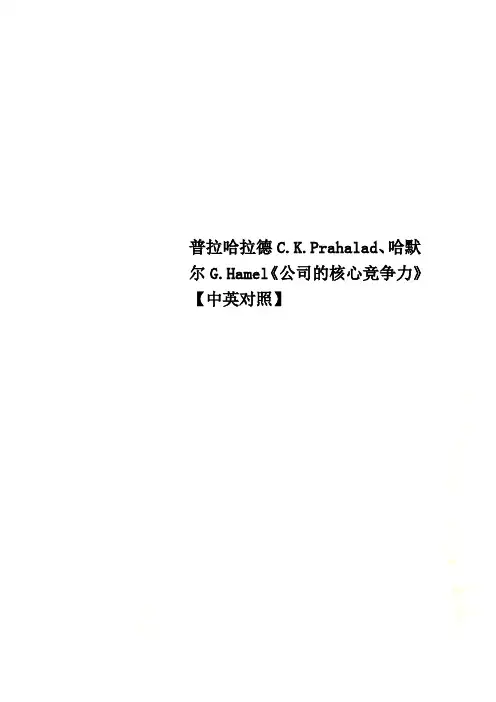
普拉哈拉德C.K.Prahalad、哈默尔G.Hamel《公司的核心竞争力》【中英对照】普拉哈拉德公司的核心竞争力1990年普拉哈拉德(C.K.Prahalad)和哈默尔(G.Hamel)在哈佛商业评论上发表?企业核心竞争力?(TheCoreCompetenceoftheCorporation)1C)开展为“超大规模集成电路〞(VLSl),通信方面那么从机械式纵横交换机演化为复杂的数字传输系统,即我们所说的ISDN(综合业务数字网)。
随着形势进一步开展,NEC认为,计算、通信和元件业务将逐渐重叠和交织在一起,以至于最后很难将它们区分开来。
如果一家公司具备了效劳于这三个市场的核心竞争力,那么到那时,必然会获得巨大的商机。
NEC的高层领导决定把半导体列为公司最重要的“核心产品〞(coreproduct)。
它随后与很多公司结成了战略联盟,到1987年联盟数量已到达100多个,其目的就是为了以低本钱快速构建企业的核心竞争力。
在大型主机领域,NEC最著名的合作伙伴是美国的霍尼韦尔公司(Honeywell)与法国的Bull公司。
在半导体元件领域,几乎所有的合作工程都是以获取技术为目的。
在结盟时,NEC的运营经理对合作动机和目的非常明确:吸收和消化合作伙伴的技能。
NEC的研发总监曾这样总结20世纪70年代和80年代获取技能的经历:“从投资角度分析,这种方式使我们能够以更低的本钱迅速掌握国外技术。
我们没有必要自己开发新的创意。
〞而GTE似乎并没有如此明确的战略意图和战略架构。
尽管高层决策者也曾讨论过信息技术的开展将带来怎样的影响,但对于在信息技术行业竞争将需要什么样的能力(competencies),并没有形成一致的观点,更谈不上将其在公司中广泛传播了。
虽然公司做了大量工作来确认关键技术,但高层业务经理依然我行我素,仿佛他们经营的业务单元与别的单元毫不相干。
权力分散导致公司无法集中开展核心竞争力。
相反,各业务单元越来越依靠外面的公司来获得关键技能,而对外合作那么成了一种分阶段退出的途径。
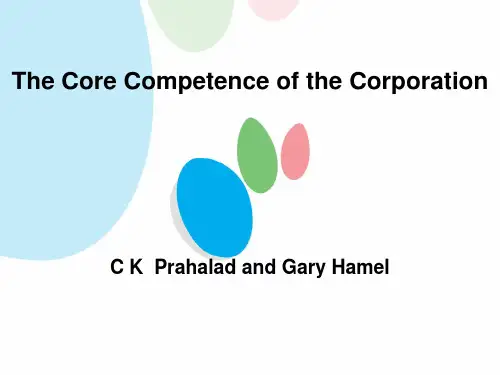
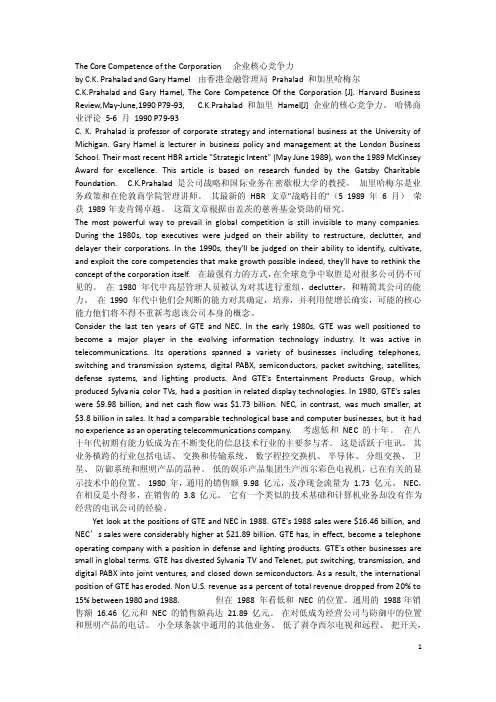
The Core Competence of the Corporation 企业核心竞争力by C.K. Prahalad and Gary Hamel 由香港金融管理局Prahalad 和加里哈梅尔C.K.Prahalad and Gary Hamel, The Core Competence Of the Corporation [J]. Harvard Business Review,May-June,1990 P79-93, C.K.Prahalad 和加里Hamel[J] 企业的核心竞争力。
哈佛商业评论5-6 月1990 P79-93C. K. Prahalad is professor of corporate strategy and international business at the University of Michigan. Gary Hamel is lecturer in business policy and management at the London Business School. Their most recent HBR article "Strategic Intent" (May June 1989), won the 1989 McKinsey Award for excellence. This article is based on research funded by the Gatsby Charitable Foundation. C.K.Prahalad 是公司战略和国际业务在密歇根大学的教授。
加里哈梅尔是业务政策和在伦敦商学院管理讲师。
其最新的HBR 文章"战略目的"(5 1989 年 6 月)荣获1989年麦肯锡卓越。
这篇文章根据由盖茨的慈善基金资助的研究。
The most powerful way to prevail in global competition is still invisible to many companies. During the 1980s, top executives were judged on their ability to restructure, declutter, and delayer their corporations. In the 1990s, they'll be judged on their ability to identify, cultivate, and exploit the core competencies that make growth possible indeed, they'll have to rethink the concept of the corporation itself.在最强有力的方式,在全球竞争中取胜是对很多公司仍不可见的。
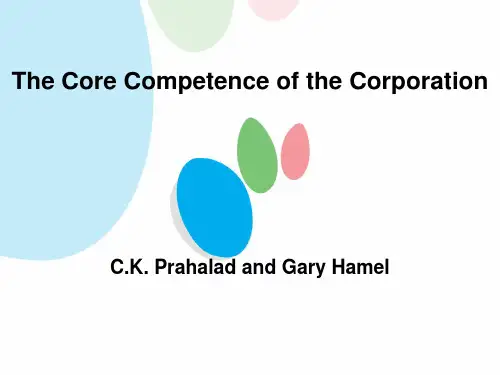
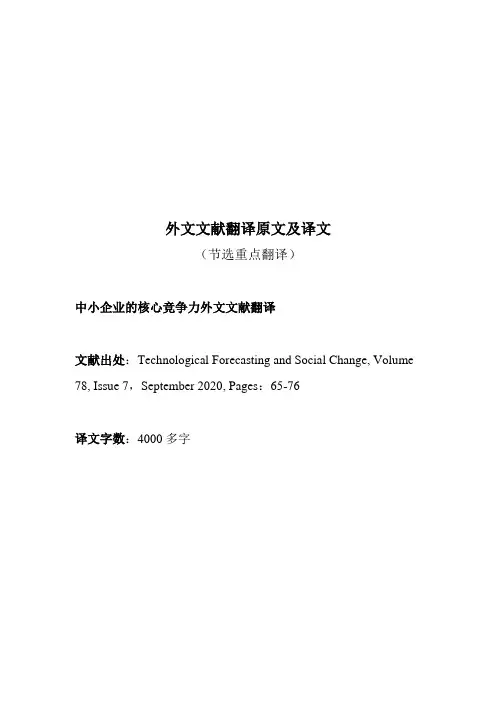
外文文献翻译原文及译文(节选重点翻译)中小企业的核心竞争力外文文献翻译文献出处:Technological Forecasting and Social Change, Volume 78, Issue 7,September 2020, Pages:65-76译文字数:4000 多字英文The Core Competitiveness of Small and Medium EnterprisesJoseph OstroyAbstractSMTE faced severe competition in today’s market. In this paper, core competitiveness is describe as the source of persistent competitive advantage of enterprise, and yields generous profits in new business environment. The study aimed at develop enterprise strategies to promote core competitiveness, also referring to core competitiveness as both prerequisite and final target to develop enterprise strategies in today’s business environment.Keywords: Core Competitiveness, SMTE, Enterprise Strategies.1 IntroductionThe definition of SMTE in China is originated from "Innovation Fund Temporary Provisions for Mid- and Small-Scale Technology Enterprise" which enact by Science and technology Department & Ministry of Finance in 1995.The provision required SMET to meet the standards as follows: (1) “no more than500 employees, among which technicians qualified for a higher education than colleges and universities is no less than 30 percent”; (2) “should mainly engaged in the development, exploitation, production andservice of new and high-tech products”; (3) “enterprise leaders are relatively capable of innovation, market development and management”;(4) “the funds for R&D of new and high-tech products is no less than 3 percent of the sales every year, and technicians directly related to R&D are more than 10 percent of all employees”; (5) good management and achievement are required to enterprises which have leading products and will come to the stage of mass production, as well as those which have come to the stage of mass production.The SMTE develops rapidly due to the predominance of technology and innovation. However, the restrictions upon the SMTE and the entry into WTO put them into a cruelly fierce competition with big enterprises home and abroad which have accumulated rich market experiences. In such a case, if SMTE can’t find the position and make full use of their advantages, they may have problems to survive, to say nothing of development.The core competitiveness of an enterprise is the long-term formation of the enterprise, which is embedded in the internal quality of the enterprise and unique to the enterprise. It supports the past, present and future competitive advantages of the enterprise, and becomes the core ability that the enterprise can surpass to obtain the initiative in the competitive environment. Enterprise core competitiveness is the source of persistent competitive advantage of enterprise, and yields generous profits.Thus, to survive and develop, SMTE may promote core competitiveness which can be achieved by enterprise strategy. So, the important method which guides SMTE to survive and develop is to identify and estimate enterprise core competitiveness, to develop reasonable, scientific and feasible developmental strategies on the basis of identification of exterior and inner environment.As the "engine" to gain the advantages of enterprises, core competitiveness must have its own characteristics:•Value. The core competitiveness has unique value to the enterprise and customers, and has a special contribution to the enterprise to win and maintain its competitive advantage. The core competitiveness is conducive to the improvement of the efficiency of the enterprise, which can enable the enterprise to provide users with more use value than other companies in terms of value creation and cost reduction. It can enable enterprises to have higher labor efficiency and converted product costs than leading, thereby obtaining higher and long-term economic benefits and maximizing enterprise value.•Extensibility or overlap. Provide support for a variety of products or services. Once an enterprise has established its own core competitiveness, it can make related technical fields and new innovations a big win. Because in the production practice, enterprises can combine their core competitiveness into different innovations to accumulate newfoundations for creation and development, and then establish their own competitive advantages in certain fields, and constantly launch innovations.•Difficult to imitate or imitation. A company's core competitiveness should be unique to the company, that is, other companies do not have it (at least temporarily not participating), and it is not imitable and irreplaceable. This is the case of the company Porsche, as a German company. Small and medium-sized automobile companies, in a wide variety of automobile industries, Porsche only chooses sports cars as the main product, and is known for creating outstanding performance and noble quality. The circled customers are obsessed with "driving wisdom, galloping technology" The car family has formed a unique product positioning, unique customer positioning, unique price positioning and continuous innovation to meet the needs of customers. It is unique in the manufacturing industry and creates first-class economic benefits.•The core competitiveness is constantly evolving. If the external environment undergoes drastic changes or is poorly managed, the core competitiveness of an enterprise at a certain stage will depreciate into general capabilities or be lost. The core competitiveness also has a life cycle from birth, growth, growth to decline. After the reduction, the core competitiveness of the enterprise, especially the final product, core product, and core technology will shift the intensified market competitionand the development of science and technology, while gradually losing its competitive advantage or even being eliminated. Therefore, enterprises must constantly manage the development trend of the industry, the development trend of the enterprise and the storage status of the enterprise's own resources, and timely improve the core competitiveness of the enterprise. Core competitiveness needs timely protection and innovation.•Interrelatedness. Core competitiveness is a collection of skills and technologies, rather than scattered skills or technologies. The core competitiveness is generated by the interaction of many different units or individuals. Its carrier is the entire enterprise, not a certain department of the enterprise. The formation of the core competitiveness of an enterprise is bound to be the result of the overall optimization of the enterprise.2 Current ResearchIn order to study enterprise core competitiveness and developmental strategy which are interrelated with each other, current research focus on concrete enterprise, or general enterprise. Current research focus on three main headings: the significance of certain enterprise strategy used to promote enterprise core competitiveness; select enterprise strategy or the executive mode of certain strategy according to the source and level of advantages related to core competitiveness; select proper developmental strategy so as to promote enterprise core competitiveness.In this paper, study aimed at SMTE core competitiveness and developmental strategies is supposed to be developed, especially, put core competitiveness as both prerequisite and final target to develop enterprise strategies, is applied to SMTE for core competitiveness analysis.3 Theoretical ResearchWe may consider that, the structure and developmental level of enterprise core competitiveness advantages plays a critical role in inner environment of enterprise, and embodies the core strength, so it is an important base for enterprise to select and develop strategies. Meanwhile, to enterprise, core competitiveness is the source of development, is the goal of growth, and is the necessity of strategies. Furthermore, the structure of enterprise core competitiveness pointed out the direction how enterprises make a long-term existence and how they realize enterprise strategy. The most important is that, enterprise core competitiveness is dynamical and relative, so it is necessary to maintain and develop it persistently.This paper’s idea is, by enterprise core competitiveness theory, obtaining estimation system and method on the basis of analyzing the structure of SMTE core competitiveness concretely. Then, we obtain the analytical framework of inner and exterior environment related to SMTE, and try to give multistage developmental strategy of SMTE in its general sense. We have to point out two relations here: first, the goal of enterprisedevelopmental strategy is defined by the structure of SMTE core competitiveness; second, the structure and level of SMTE core competitiveness is most important content of enterprise inner environment, defines enterprise’s advantage source and advantage degree, so that it exercises an influence on the choice of enterprise strategies. So we may conclude that core competitiveness and level are target and condition of strategical choice.4 Analytical Model of SMTE Developmental Strategy Based on Core CompetitivenessThere are meanings about SMTE developmental strategy based on core competitiveness: first, the developmental strategy is aimed at maintaining and promoting SMTE core competitiveness; second, in order to establish the developmental strategy, we need to inspect inner and external environmental factors comprehensively, especially, the situation of enterprise core competitiveness, which includes the structure and level of core competitiveness. Third, the developmental strategy mainly focuses on every factors influencing core competitiveness level.4.1Analytical Model of SMTE External EnvironmentThe analysis of SMTE external environment refers to those factors which are external to the SMTE and have a potential impact on SMTE, and according to different influence circle, it is divided into macroscopic environment analysis and analysis of industry lifecycle and industrycompetition.(1)Analytical model of macroscopic environmentAnalysis of macroscopic environment includes PEST analysis and environmental uncertainty analysis, among which, PEST (Political, Economic, Social, and Technological) analysis is shown as Fig: Uncertainty analysis is the analysis of complexity and varying speed of four primary influential factors. Environmental uncertainty level is measured by two points: one is the simple complexity, which means quantity and diversity degree of external factors related to SMTE running, and the other is degree of stability, which means varying rate of external environment.(2) Analytical model of SMTE’s industrial life circle and industrial competition Generally speaking, industrial life circle is divided into formative period, growing period, mature period and declining period, so as to the industries SMTE reside in. Now, we study the influence of industry life circle to strategy, and give the analytical framework of industry life circle based on the indicator characteristics which include market development, market structure, production series, financial affairs and current situation of production and so on, and which are separately analyzed by four periods of the industrial circle that SMTE belong to.4.2 Analytical Model of SMTE Inner EnvironmentThe analysis of SMTE inner environment includes three aspects: analysis of resources hold by SMTE, capability analysis, and core competitiveness analysis.Resources refer to the production factors which enterprises use to provide customs value product and services, they are generally divided into three categories: material resources, intangible resources and human resources, and they are displayed in Table. The goal of analysis to SMTE capability and core competitiveness is to make varieties of the capabilities that enterprise use to create or maintain competitive advantage clear, is to understand enterprise’ core specialty, is to know enterprise’ competitive disadvantage. SMTE capability analysis means analyzing the capability that SMTE integrating resources so as to accomplish certain goal. The commonly used method is Baud’s value chain analysis.Two methods can be used to analyze SMTE core competitiveness: one is the qualitative method, in which six standards are used to judge whether a resource or capability is the core capability; the other is the quantitative method, that is to say, the method to establish and apply indicator system estimation mentioned before.4.3 SMTE Strategic Choice MethodSMTE strategic choice inspects the results of enterprise inner and external environment synthetically. So, for the purpose of developing reasonable strategy to guide enterprise development, we have to analyzethe factors revealing SMTE inner and external environment.This paper adopts strategic position and action assessment matrix (SPACE) to analyze SMTE inner and external environment concretely, and makes corresponding strategic choices by the analysis. Matrix SPACE uses four-dimensional system of coordinate. Generally, the horizontal axis represents two enterprise external factors: environmental stability (ES) and industrial stability (IS), and the vertical axis represent two enterprise inner factors: financial strength (FS) and competitive advantage (CA), as shown in Fig.5 ConclusionEnterprise developmental strategies are composed of three levels: corporation strategy, business strategy and functional strategy. Now, starting with the promotion of SMTE core competitiveness, we combine SMTE inner and external environment and give SMTE multiple developmental strategies.Growing strategy, that is to say, the expanding strategy is supposed to the first choice of SMTE corporation strategy.Among competitive strategies, cost excelling strategy makes no great sense to SMTE, but production diversity strategy and concentration strategy are good to SMTE. Production diversity strategy avoids the price war while satisfying certain consumptive groups, so it brings high profit. Concentration strategy avoids direct confliction with competitors in largescale, which brings growing production, lower cost, and bigger competitive advantage based on concentration of lesser resources.SMTE functional strategy assumes the responsibility of resource accumulation and core competitiveness promotion while thining enterprise overall strategy and competitive strategy.• Technology innovation strategy. First, enterprise should value technology innovation highly. Second, the training and development of enterprise technicians, especially the R&D technicians should be made much account of. Third, enterprise may increase the devotion on R&D to maintain the level of technology and production. Otherwise, enterprise could cooperate with colleges and universities which have technological advantage in related domain to speed up enterprise technology i nnovation.• Financing strategy. Lacking of capital has restricted SMTE from further development, including narrow financing channels, high financing cost, disordered financing proportion, single financial service, and so on. Seeking for capital support of government is an effective capital resource for survival and development of SMTE.• Human resources strategy. First, effective knowledge management and new structure fitting knowledge innovation is critical. Second, human resources training system is need to be established.• Enterprise culture strategy. Enterprise culture generally includes the values, brand, and inner image of the enterprise, among which valuesis the core by leading the development of whole enterprise. First, enterprise should build up the values of “innovation”, “learning”, “science”, and then set up brand sense, emphasize enterprise characteristics. Meanwhile, enterpriser factors are highly valued and enterprisers’ good qualities are brought up.译文中小企业的核心竞争力研究约瑟夫·奥斯特罗伊摘要中小企业在当今市场上正面临着激烈的竞争。
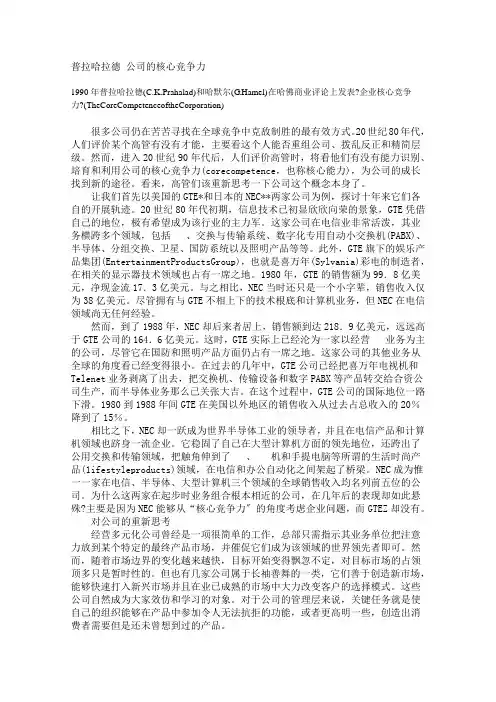
普拉哈拉德公司的核心竞争力1990年普拉哈拉德(C.K.Prahalad)和哈默尔(G.Hamel)在哈佛商业评论上发表?企业核心竞争力?(TheCoreCompetenceoftheCorporation)很多公司仍在苦苦寻找在全球竞争中克敌制胜的最有效方式。
20世纪80年代,人们评价某个高管有没有才能,主要看这个人能否重组公司、拨乱反正和精简层级。
然而,进入20世纪90年代后,人们评价高管时,将看他们有没有能力识别、培育和利用公司的核心竞争力(corecompetence,也称核心能力),为公司的成长找到新的途径。
看来,高管们该重新思考一下公司这个概念本身了。
让我们首先以美国的GTE*和日本的NEC**两家公司为例,探讨十年来它们各自的开展轨迹。
20世纪80年代初期,信息技术已初显欣欣向荣的景象,GTE凭借自己的地位,极有希望成为该行业的主力军。
这家公司在电信业非常活泼,其业务横跨多个领域,包括、交换与传输系统、数字化专用自动小交换机(PABX)、半导体、分组交换、卫星、国防系统以及照明产品等等。
此外,GTE旗下的娱乐产品集团(EntertainmentProductsGroup),也就是喜万年(Sylvania)彩电的制造者,在相关的显示器技术领域也占有一席之地。
1980年,GTE的销售额为99.8亿美元,净现金流17.3亿美元。
与之相比,NEC当时还只是一个小字辈,销售收入仅为38亿美元。
尽管拥有与GTE不相上下的技术根底和计算机业务,但NEC在电信领域尚无任何经验。
然而,到了1988年,NEC却后来者居上,销售额到达218.9亿美元,远远高于GTE公司的164.6亿美元。
这时,GTE实际上已经沦为一家以经营业务为主的公司,尽管它在国防和照明产品方面仍占有一席之地。
这家公司的其他业务从全球的角度看已经变得很小。
在过去的几年中,GTE公司已经把喜万年电视机和Telenet业务剥离了出去,把交换机、传输设备和数字PABX等产品转交给合资公司生产,而半导体业务那么已关张大吉。
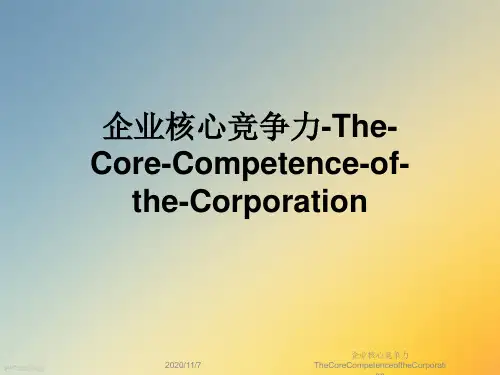
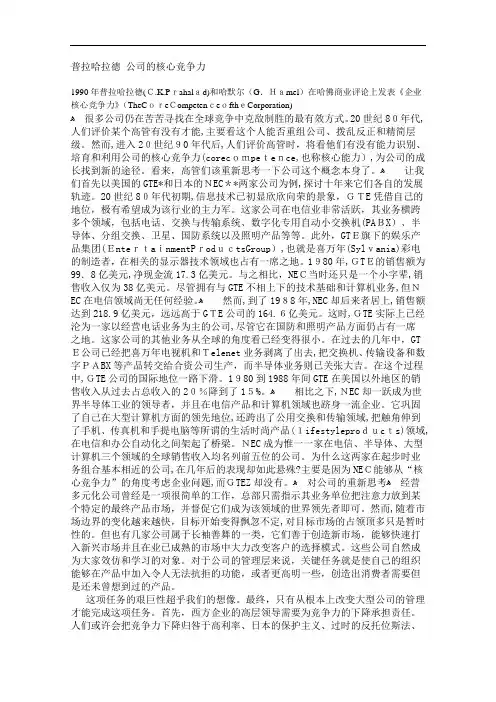
普拉哈拉德公司的核心竞争力1990年普拉哈拉德(C.K.Prahalad)和哈默尔(G.Hamel)在哈佛商业评论上发表《企业核心竞争力》(TheCoreCompetenceoftheCorporation)ﻫ很多公司仍在苦苦寻找在全球竞争中克敌制胜的最有效方式。
20世纪80年代,人们评价某个高管有没有才能,主要看这个人能否重组公司、拨乱反正和精简层级。
然而,进入20世纪90年代后,人们评价高管时,将看他们有没有能力识别、培育和利用公司的核心竞争力(corecompetence,也称核心能力),为公司的成长找到新的途径。
看来,高管们该重新思考一下公司这个概念本身了。
ﻫ让我们首先以美国的GTE*和日本的NEC**两家公司为例,探讨十年来它们各自的发展轨迹。
20世纪80年代初期,信息技术已初显欣欣向荣的景象,GTE凭借自己的地位,极有希望成为该行业的主力军。
这家公司在电信业非常活跃,其业务横跨多个领域,包括电话、交换与传输系统、数字化专用自动小交换机(PABX)、半导体、分组交换、卫星、国防系统以及照明产品等等。
此外,GTE旗下的娱乐产品集团(EntertainmentProductsGroup),也就是喜万年(Sylvania)彩电的制造者,在相关的显示器技术领域也占有一席之地。
1980年,GTE的销售额为99.8亿美元,净现金流17.3亿美元。
与之相比,NEC当时还只是一个小字辈,销售收入仅为38亿美元。
尽管拥有与GTE不相上下的技术基础和计算机业务,但NEC在电信领域尚无任何经验。
ﻫ然而,到了1988年,NEC却后来者居上,销售额达到218.9亿美元,远远高于GTE公司的164.6亿美元。
这时,GTE实际上已经沦为一家以经营电话业务为主的公司,尽管它在国防和照明产品方面仍占有一席之地。
这家公司的其他业务从全球的角度看已经变得很小。
在过去的几年中,GT E公司已经把喜万年电视机和Telenet业务剥离了出去,把交换机、传输设备和数字PABX等产品转交给合资公司生产,而半导体业务则已关张大吉。
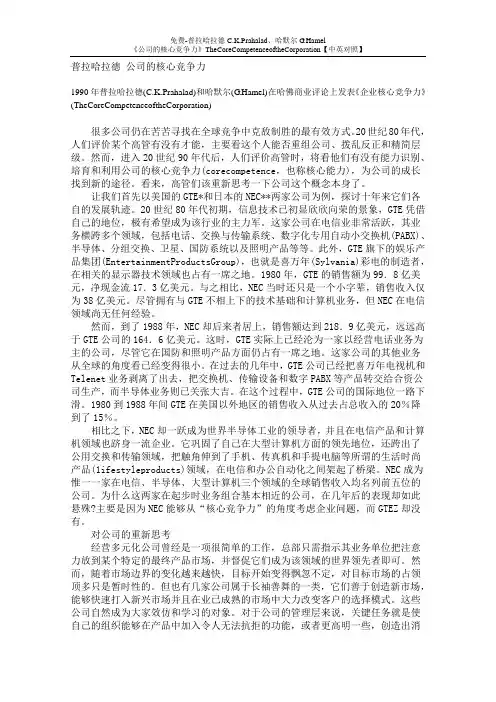
普拉哈拉德公司的核心竞争力1990年普拉哈拉德(C.K.Prahalad)和哈默尔(G.Hamel)在哈佛商业评论上发表《企业核心竞争力》(TheCoreCompetenceoftheCorporation)很多公司仍在苦苦寻找在全球竞争中克敌制胜的最有效方式。
20世纪80年代,人们评价某个高管有没有才能,主要看这个人能否重组公司、拨乱反正和精简层级。
然而,进入20世纪90年代后,人们评价高管时,将看他们有没有能力识别、培育和利用公司的核心竞争力(corecompetence,也称核心能力),为公司的成长找到新的途径。
看来,高管们该重新思考一下公司这个概念本身了。
让我们首先以美国的GTE*和日本的NEC**两家公司为例,探讨十年来它们各自的发展轨迹。
20世纪80年代初期,信息技术已初显欣欣向荣的景象,GTE凭借自己的地位,极有希望成为该行业的主力军。
这家公司在电信业非常活跃,其业务横跨多个领域,包括电话、交换与传输系统、数字化专用自动小交换机(PABX)、半导体、分组交换、卫星、国防系统以及照明产品等等。
此外,GTE旗下的娱乐产品集团(EntertainmentProductsGroup),也就是喜万年(Sylvania)彩电的制造者,在相关的显示器技术领域也占有一席之地。
1980年,GTE的销售额为99.8亿美元,净现金流17.3亿美元。
与之相比,NEC当时还只是一个小字辈,销售收入仅为38亿美元。
尽管拥有与GTE不相上下的技术基础和计算机业务,但NEC在电信领域尚无任何经验。
然而,到了1988年,NEC却后来者居上,销售额达到218.9亿美元,远远高于GTE公司的164.6亿美元。
这时,GTE实际上已经沦为一家以经营电话业务为主的公司,尽管它在国防和照明产品方面仍占有一席之地。
这家公司的其他业务从全球的角度看已经变得很小。
在过去的几年中,GTE公司已经把喜万年电视机和Telenet业务剥离了出去,把交换机、传输设备和数字PABX等产品转交给合资公司生产,而半导体业务则已关张大吉。
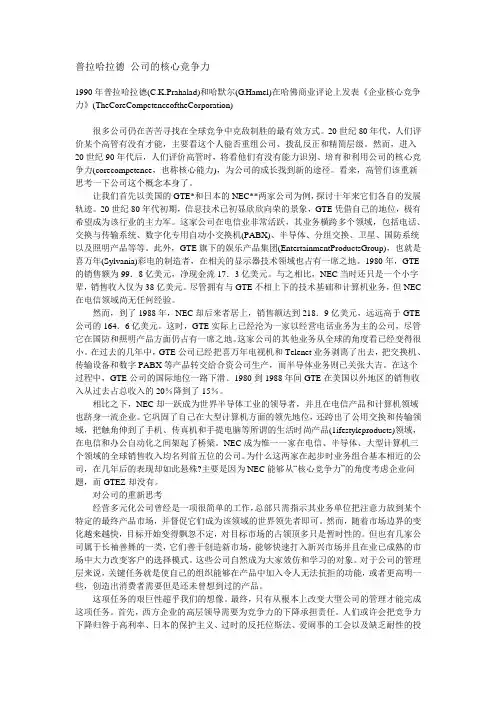
普拉哈拉德公司的核心竞争力1990年普拉哈拉德(C.K.Prahalad)和哈默尔(G.Hamel)在哈佛商业评论上发表《企业核心竞争力》(TheCoreCompetenceoftheCorporation)很多公司仍在苦苦寻找在全球竞争中克敌制胜的最有效方式。
20世纪80年代,人们评价某个高管有没有才能,主要看这个人能否重组公司、拨乱反正和精简层级。
然而,进入20世纪90年代后,人们评价高管时,将看他们有没有能力识别、培育和利用公司的核心竞争力(corecompetence,也称核心能力),为公司的成长找到新的途径。
看来,高管们该重新思考一下公司这个概念本身了。
让我们首先以美国的GTE*和日本的NEC**两家公司为例,探讨十年来它们各自的发展轨迹。
20世纪80年代初期,信息技术已初显欣欣向荣的景象,GTE凭借自己的地位,极有希望成为该行业的主力军。
这家公司在电信业非常活跃,其业务横跨多个领域,包括电话、交换与传输系统、数字化专用自动小交换机(PABX)、半导体、分组交换、卫星、国防系统以及照明产品等等。
此外,GTE旗下的娱乐产品集团(EntertainmentProductsGroup),也就是喜万年(Sylvania)彩电的制造者,在相关的显示器技术领域也占有一席之地。
1980年,GTE 的销售额为99.8亿美元,净现金流17.3亿美元。
与之相比,NEC当时还只是一个小字辈,销售收入仅为38亿美元。
尽管拥有与GTE不相上下的技术基础和计算机业务,但NEC 在电信领域尚无任何经验。
然而,到了1988年,NEC却后来者居上,销售额达到218.9亿美元,远远高于GTE 公司的164.6亿美元。
这时,GTE实际上已经沦为一家以经营电话业务为主的公司,尽管它在国防和照明产品方面仍占有一席之地。
这家公司的其他业务从全球的角度看已经变得很小。
在过去的几年中,GTE公司已经把喜万年电视机和Telenet业务剥离了出去,把交换机、传输设备和数字PABX等产品转交给合资公司生产,而半导体业务则已关张大吉。
针对一个公司的真正的核心竞争力外文翻译外文翻译Targeting a Company's Real Core CompetenciesMaterial Source: Journal of Business Strategy, 1993 volume13 issue 6 Author: Amy V. Snyder and H. William Ebeling, Jr.The twin concepts of core competence and business processes figure prominently in most discussions of corporate strategy. The core competence concept helps top managers answer the fundamental question "What should we do?" and the business processes perspective addresses the question "How should we do it?"Both concepts are indispensable in guiding firms to achieve enduring competitive advantage and superior profitability, and both are founded on a simple notion: that the firm is a system of activities, not a portfolio of individual products or services. Some activities are performed so much better than the competition and are so critical to end products or services that they can be described as core competencies. When a series of activities are organized into a system that works better than the sum of its parts, this business process can also create competitive advantage, even if component activities by themselves do not.While business process reengineers have achieved significantsuccess in decreasing costs while simultaneously improving service levels, relatively few firms claim to have correctly identified and fully exploited their core competencies or key activities. Throughout this article, we will use the terms core competency and key activity interchangeably. Business process reengineers have developed an analytically rigorous discipline that can be systematically applied and plainly communicated to others. For the core competency concept to achieve this same success, it must be linked to the underlying business economics that drive competitive advantage, and it must be applied in the same systematic manner as the business process concept.In the mid-1970s, corporate planners began to question whether the product-centered business unit was the most appropriate unit of strategic analysis. In work undertaken for a global chemical company in 1977, Braxton Associates redefined the unit of analysis from product-centered business units to activities and developed insights about how competitive advantage is created in the long run.In the course of our work with the chemical company, we demonstrated that gaining a strong relative share in key value-added activities is more relevant to competitive position than gaining share of the related product market. In the 1970s, we used the slicing knife schematic to demonstrate that assessing competitive advantage from a product perspective can lead to erroneous conclusions. The insight thatunderlies the activity perspective is that a firm can not be viewed only as a collection of individual products or services this merely describes the revenue-generating side of the firm. Equally important, the firm is a system of activities that must be organized and managed to imize the value of its offerings while minimizing their cost that is, to create competitive advantage.The slicing knife example makes an important point, but a key question remains. Once it is determined that a firm enjoys a comparatively strong activity position, the next logical question is "So what?" Achieving strong activity position is critical to competitiveness only when the particular activity adds significant value to the end product or service.In the 1980s, Michael Porter documented the concept of the value chain and used it to show how a series of activities could be viewed as a system designed to create competitive advantagePorter's work was instrumental in popularizing the activity perspective and the importance of activity linkages However, the popular version of Porter's value chain does not consider the value-added concept in sufficient depth. This is unfortunate,because the value-added structure determines which activities are critical to success and which are not.It is usually a mistake to invest heavily in activities that represent only a small fraction of the overall value of a firm's productsor services. The company that produced the page you are now reading would be better off with a competency in printing and page setup than in packaging, even though the printed journal was delivered in a protective package, because packaging does not represent a significant fraction of the overall value of the delivered journal.FOUR IMPERATIVES OF CORE COMPETENCIESThe GE and Honda examples demonstrate the importance of organizing around "real" core competencies or activities and the implications of failing to do so. Once senior management develops the strategic intent to identify, nurture, and organize around activities that can be made unique and enduring, a few rules must be followed to transform this commitment into competitive success.Rule 1: Avoid laundry listsIf senior management settles on more than a handful of key activities or core competencies, it is probably over-reaching and certainly ignoring the intent of the word core. Many successful companies have targeted either one or two key activities Identifying key activities is one of the most important contributions senior management can make. In our view, proposed core competencies should: Contribute significantly to the ultimate value of the end product or service.Represent a unique capability that provides enduring competitiveadvantage Have the potential to support multiple end products or services Rule 2: Achieve senior management consensus on core competencies What business are you really in?Evaluating potential core competencies using the previously described screening approach is a necessary but insufficient step in building a competency driven organization. If competencies are to be nurtured and shared widely throughout the firm, senior management must reach consensus on which these are and act on the results of their selection process In working to build senior management consensus on key activities, we have achieved good results using the following approaches among others:Activity-based benchmarking.Employee and asset distribution."What if" scenario development.Activity-based benchmarking is a technique that can steer debate away from subjective opinions and toward hard facts. For example, if the vice president of operations claims that order processing and fulfillment is a core competency, he could develop a persuasive argument by demonstrating an enduring competitive advantage in order processing speed, cost, and customer satisfaction.A compelling argument can also be built by answering some simple questions about an organization's internal configuration, for example:"What do your employees do? Where are your assets?" If 80% of a company's employees are on the plant floor, the marketing vice-president must argue persuasively to convince his colleagues that marketing and sales is really a key activity. After all, people embody the collective learning so extolled today, and learning becomes a formidable competitive weapon when it is built up and shared among a large number of employees "What if" approaches are also useful in working with a group to select core competencies. A senior management deadlock can often be broken by working out the implications of selecting a single core competency as a guide for future actions.In a deadlocked situation, one might ask "What actions are implied by the adoption of core competency 'X'? What products and markets are most attractive given this core competency? What will the company look like five years from now if competency 'X' guides our actions?"These same questions should be answered for each proposed core competency. While this approach may seem simplistic, it can be combined with other, more analytical approaches to help the group reach consensus on a core competency or two that makes the most sense for the corporation.Rule 3: Leverage core competencies inside the organizationOnce senior management identifies and agrees on the firm's core competencies, it must work zealously to ensure that competencies are continually strengthened, shared widely throughout the corporation, andmanaged in a way that best preserves the competitive advantages they create. The importance of this mandate cannot be stressed enough-if senior management fails to organize around key activities, they will disappear.Recall the slicing knife example: while the electric motor manufacturing activity enjoys a strong relative activity share, motor costs will not necessarily be lower than that of the competition. Only if this company organizes and conducts its operations so as to capture the collective learning taking place in the motor manufacturing activity will it drive costs down as cumulative experience increases.Actions that may be necessary to best exploit identified competencies run the spectrum from physically reconfiguring disparate manufacturing processes to simply communicating more effectively. Consider the case of a leading international manufacturer of electrical products. Division A developed expertise in the design and manufacture of surface-mounted printed circuit boards and used this skill to reduce the costs of its products. Division B had an outmoded, expensive production process, in part because it was several generations behind in printed circuit-board design. Division B could have benefitted from Division A's surface-mount expertise and in return could have driven down costs for both divisions by increasing overall volume. Instead, Division A jealously guarded its capabilities, and Division B continued to struggle.This behavior cannot be tolerated if key corporate skills are to be exploited to their fullest potential. New approaches to project coordination and interdepartmental communication can help to break down the barriers. Today, corporate planners are applauding "adaptive organizations," which retain some vestiges of the old hierarchy and maybe a few traditional departments [But rely on] a pattern of constantly changing teams, task forces, partnerships, and other informal structures.The goal of the adaptive organization is to ensure that the best core competencies, whether embodied in technologies, processes, or employees, are linked to the most promising market opportunities so that learning is imized and travels quickly throughout the corporation.Rule 4: Share core competencies outside the corporation as well Sometimes sharing and nurturing core competencies within a corporation is not enough. As markets evolve, new activities may be required. Moreover, in today's global marketplace, even giant corporations blanch at the cost of launching new products and entering new markets. With product lifecycles shrinking and R&D costs skyrocketing, some companies find it easier to embrace their competitors rather than fight them.Collins and Doorley have studied multinational alliance behavior and observe that "The corporation of the future will need to take a more dynamic view of its business. There is often insufficient time to switchfrom one mode of operation to another as markets evolve [through their product lifecycles]. From the very start of a new business, companies must find ways of building competence in each area of competitive advantage even if they are not well placed to do so on their own."Thinking about alliances from the perspective of key activities that can be shared adds clarity to a complex and difficult partner identification process. As senior executives have begun to focus on imizing the value of the core competencies they identify, alliance activity has increased substantially.REDEFINING CORE COMPETENCIESIdentifying core competencies and inspiring the organization to nurture and organize around them is one of the most important contributions senior management can make. The reverse is also true: selecting the wrong competency or too many core competencies is one of the worst conceivable management errors.It is our experience that an effort like this should be undertaken every three to five years, as part of a periodic review of corporate strategy. However, when an industry undergoes a fundamental change in its value-added structure, a reassessment is critical. Often management cannot respond fast enough and heavy losses result Western Union could not make the transition into the information age because it failed to recognize the growing importance of the transmission infrastructure; iteventually fell into bankruptcy. However, when the core check printing business of Deluxe Check Printers became threatened by electronic funds transfer EFT, Deluxe correctly perceived that it had to cultivate new skills to preserve its historical performance. Senior management redefined its core competency from printing checks to facilitating financial transactions and built a successful EFT and data processing business.In redefining its business, Deluxe recognized that its role in check clearing and processing and its financial institution marketing expertise might offer more enduring value to its customers than printing checks. Deluxe combined these enduring skills with acquired skills in computer automation, and it moved successfully in a new direction.Companies with a widely shared understanding of their unique and enduring capabilities and the evolving value-added structure of their industries will rise above the competition, just as Deluxe and Honda did. By whatever name activities, core competencies, or value-chain elements, firms that define their competitive advantage based on structural superiority in the discrete activities they perform are more often than not long-term winners; these companies turn their core competencies into competitive weapons, not competitive traps.译文针对一个公司的真正的核心竞争力资料来源: Journal of Business Strategy(商业策略期刊),1993 volume13 issue 6作者:Amy V. Snyder and H. William Ebeling, Jr.核心竞争力和业务流程的这两个双胞胎概念在多数关于公司策略的讨论中被突出地计算。
普拉哈拉德公司的核心竞争力1990年普拉哈拉德(C.K.Prahalad)和哈默尔(G.Hamel)在哈佛商业评论上发表《企业核心竞争力》(TheCoreCompetenceoftheCorporation)很多公司仍在苦苦寻找在全球竞争中克敌制胜的最有效方式。
20世纪80年代,人们评价某个高管有没有才能,主要看这个人能否重组公司、拨乱反正和精简层级。
然而,进入20世纪90年代后,人们评价高管时,将看他们有没有能力识别、培育和利用公司的核心竞争力(corecompetence,也称核心能力),为公司的成长找到新的途径。
看来,高管们该重新思考一下公司这个概念本身了。
让我们首先以美国的GTE*和日本的NEC**两家公司为例,探讨十年来它们各自的发展轨迹。
20世纪80年代初期,信息技术已初显欣欣向荣的景象,GTE凭借自己的地位,极有希望成为该行业的主力军。
这家公司在电信业非常活跃,其业务横跨多个领域,包括电话、交换与传输系统、数字化专用自动小交换机(PABX)、半导体、分组交换、卫星、国防系统以及照明产品等等。
此外,GTE旗下的娱乐产品集团(EntertainmentProductsGroup),也就是喜万年(Sylvania)彩电的制造者,在相关的显示器技术领域也占有一席之地。
1980年,GTE的销售额为99.8亿美元,净现金流17.3亿美元。
与之相比,NEC当时还只是一个小字辈,销售收入仅为38亿美元。
尽管拥有与GTE不相上下的技术基础和计算机业务,但NEC在电信领域尚无任何经验。
然而,到了1988年,NEC却后来者居上,销售额达到218.9亿美元,远远高于GTE公司的164.6亿美元。
这时,GTE实际上已经沦为一家以经营电话业务为主的公司,尽管它在国防和照明产品方面仍占有一席之地。
这家公司的其他业务从全球的角度看已经变得很小。
在过去的几年中,GTE公司已经把喜万年电视机和Telenet业务剥离了出去,把交换机、传输设备和数字PABX等产品转交给合资公司生产,而半导体业务则已关张大吉。
外文翻译原文The Core Competence of the CorporationMaterial Source:Harvard Business Review,May-June,1990 P79-93Author:C.K.Prahalad and Gary HamelC. K. Prahalad is professor of corporate strategy and international business at the University of Michigan. Gary Hamel is lecturer in business policy and management at the London Business School. Their most recent HBR article "Strategic Intent" (May June 1989), won the 1989 McKinsey Award for excellence. This article is based on research funded by the Gatsby Charitable Foundation.The Roots of Competitive AdvantageThe distinction we observed in the way NEC and GTE conceived of themselves a portfolio of competencies versus a portfolio of businesses was repeated across many industries. From 1980 to 1988, Canon grew by 264%, Honda by 200%. Compare that with Xerox and Chrysler. And if Western managers were once anxious about the low cost and high quality of Japanese imports, they are now overwhelmed by the pace at which Japanese rivals are inventing new markets, creating new products, and enhancing them. Canon has given us personal copiers; Honda has moved from motorcycles to four wheel off road buggies. Sony developed the 8mm camcorder, Yamaha, the digital piano. Komatsu developed an underwater remote controlled bulldozer, while Casio's latest gambit is a small screen color LCD television. Who would have anticipated the evolution of these vanguard markets?In more established markets, the Japanese challenge has been just as disquieting. Japanese companies are generating a blizzard of features and functional enhancements that bring technological sophistication to everyday products. Japanese car producers have been pioneering four wheel steering, four valve-per cylinder engines, in car navigation systems, and sophisticated electronic engine management systems. On the strength of its product features, Canon is now a player in facsimile transmission machines, desktop laser printers, even semiconductor manufacturing equipment.In the short run, a company's competitiveness derives from the price/performance attributes of current products. But the survivors of the first wave of global competition, Western and Japanese alike, are all converging on similar and formidable standards for product cost and quality minimum hurdles for continued competition, but less and less important as sources of differential advantage. In the long run, competitiveness derives from an ability to build, at lower cost and more speedily than competitors, the core competencies that spawn unanticipated products. The real sources of advantage are to be found in management's ability to consolidate corporatewide technologies and production skills into competencies that empower individual businesses to adapt quickly to changing opportunities.Senior executives who claim that they cannot build core competencies either because they feel the autonomy of business units is sacrosanct or because their feet are held to the quarterly budget fire should think again. The problem in many Western companies is not that their senior executives are any less capable than those in Japan nor that Japanese companies possess greater technical capabilities. Instead, it is their adherence to a concept of the corporation that unnecessarily limits the ability of individual businesses to fully exploit the deep reservoir of technological capability that many American and European companies possess.The diversified corporation is a large tree. The trunk and major limbs are core products, the smaller branches are business units; the leaves, flowers, and fruit are end products. The root system that provides nourishment, sustenance, and stability is the core competence. You can miss the strength of competitors by looking only at their end products, in the same way you miss the strength of a tree if you look only at its leaves. (See the chart "Competencies: The Roots of Competitiveness.”) Core competencies are the collective learning in the organization, especially how to coordinate diverse production skills and integrate multiple streams of technologies. Consider Sony's capacity to miniaturize or Philips's optical media expertise. The theoretical knowledge to put a radio on a chip does not in itself assure a company the skill to produce a miniature radio no bigger than a business card. To bring off this feat, Casio must harmonize know how in miniaturization, microprocessor design, material science, and ultrathin precision casing the same skills it applies in its miniature card calculators, pocket TVs, and digital watches.If core competence is about harmonizing streams of technology, it is also about the organization of work and the delivery of value. Among Sony's competencies is miniaturization. To bring miniaturization to its products, Sony must ensure thattechnologists, engineers, and marketers have a shared understanding of customer needs and of technological possibilities. The force of core competence is felt as decisively in services as in manufacturing. Citicorp was ahead of others investing in an operating system that allowed it to participate in world markets 24 hours a day. Its competence in provided the company the means to differentiate itself from many financial service institutions.Core competence is communication, involvement, and a deep commitment to working across organizational boundaries. It involves many levels of people and all functions. World class research in, for example, lasers or ceramics can take place in corporate laboratories without having an impact on any of the businesses of the company. The skills that together constitute core competence must coalesce around individuals whose efforts are not so narrowly focused that they cannot recognize the opportunities for blending their functional expertise with those of others in new and interesting ways.Core competence does not diminish with use. Unlike physical assets, which do deteriorate over time, competencies are enhanced as they are applied and shared. But competencies still need to be nurtured and protected; knowledge fades if it is not used. Competencies are the glue that binds existing businesses. They are also the engine for new business development. Patterns of diversification and market entry may be guided by them, not just by the attractiveness of markets.Consider 3M's competence with sticky tape. in dreaming up businesses as diverse as "Post it" notes, magnetic tape, photographic film, pressure sensitive tapes, and coated abrasives, the company has brought to bear widely shared competencies in substrates, coatings, and adhesives and devised various ways to combine them. Indeed, 3M has invested consistently in them. What seems to be an extremely diversified portfolio of businesses belies a few shared core competencies.In contrast, there are major companies that have had the potential to build core competencies but failed to do so because top management was unable to conceive of the company as anything other than a collection of discrete businesses. GE sold much of its consumer electronics business to Thomson of France, arguing that it was becoming increasingly difficult to maintain its competitiveness in this sector. That was undoubtedly so, but it is ironic that it sold several key businesses to competitors who were already competence leaders Black & Decker in small electrical motors, and Thomson, which was eager to build its competence in microelectronics and had learned from the Japanese that a position in consumer electronics was vital to thischallenge.Management trapped in the strategic business unit (SBU) mind set almost inevitably finds its individual businesses dependent on external sources for critical components, such as motors or compressors. But these are not just components. They are core products that contribute to the competitiveness of a wide range of end products. They are the physical embodiments of core competencies.How Not to Think of CompetenceSince companies are in a race to build the competencies that determine global leadership, successful companies have stopped imagining themselves as bundles of businesses making products. Canon, Honda, Casio, or NEC may seem to preside over portfolios of businesses unrelated in terms of customers, distribution channels, and merchandising strategy. Indeed, they have portfolios that may seem idiosyncratic at times: NEC is the only global company to be among leaders in computing, telecommunications, and semiconductors and to have a thriving consumer electronics business.But looks are deceiving. In NEC, digital technology, especially VLSI and systems integration skills, is fundamental. In the core competencies underlying them, disparate businesses become coherent. It is Honda's core competence in engines and power trains that gives it a distinctive advantage in car, motorcycle, lawn mower, and generator businesses. Canon's core competencies in optics, imaging, and microprocessor controls have enabled it to enter, even dominate, markets as seemingly diverse as copiers, laser printers, cameras, and image scanners. Philips worked for more than 15 years to perfect its optical media (laser disc) competence, as did JVC in building a leading position in video recording. Other examples of core competencies might include mechantronics (the ability to marry mechanical and electronic engineering), video displays, bioengineering, and microelectronics. In the early stages of its competence building, Philips could not have imagined all the products that would be spawned by its optical media competence, nor could JVC have anticipated miniature camcorders when it first began exploring videotape technologies.Unlike the battle for global brand dominance, which is visible in the world's broadcast and print media and is aimed at building global "share of mind,” the battle to build world class competencies is invisible to people who aren't deliberately looking for it. Top management often tracks the cost and quality of competitors' products, yet how many managers untangle the web of alliances their Japanesecompetitors have constructed to acquire competencies at low cost? In how many Western boardrooms is there an explicit, shared understanding of the competencies the company must build for world leadership? Indeed, how many senior executives discuss the crucial distinction between competitive strategy at the level of a business and competitive strategy at the level of an entire company?Let us be clear. Cultivating core competence does not mean outspending rivals on research and development. In 1983, when Canon surpassed Xerox in worldwide unit market share in the copier business, its R&D budget in reprographics was but a small fraction of Xerox's. Over the past 20 years, NEC has spent less on R&D as a percentage of sales than almost all of its American and European competitors.Nor does core competence mean shared costs, as when two or more SBUs use a common facility a plant, service facility, or sales force or share a common component. The gains of sharing may be substantial, but the search for shared costs is typically a post hoc effort to rationalize production across existing businesses, not a premeditated effort to build the competencies out of which the businesses themselves grow.Building core competencies is more ambitious and different than integrating vertically, moreover. Managers deciding whether to make or buy will start with end products and look upstream to the efficiencies of the supply chain and downstream toward distribution and customers. They do not take inventory of skills and look forward to applying them in nontraditional ways. (Of course, decisions about competencies do provide a logic for vertical integration. Canon is not particularly integrated in its copier business, except in those aspects of the vertical chain that Support the competencies it regards as critical.)译文公司的核心竞争力资料来源:《哈佛商业评论》1990,5-6,P79-93作者:普拉哈拉德和哈默尔编者按:普拉哈拉德是美国密歇根大学研究公司策略和国际商务的教授。